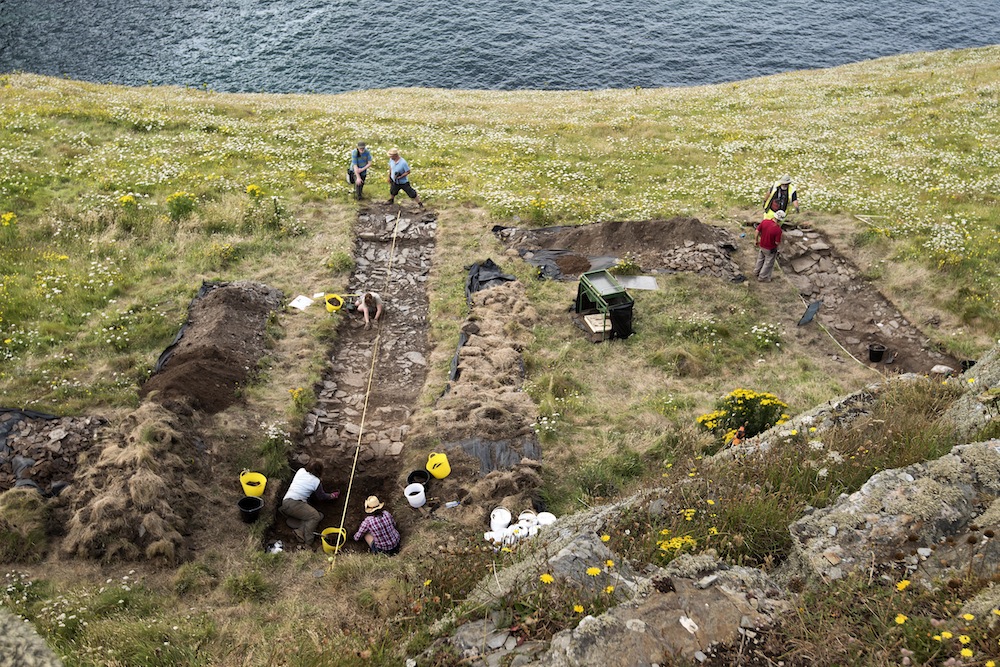King Arthur's Home? Archaeologists Investigate Legendary Birthplace

Archaeologists are investigating a mysterious coastal settlement that they think may have been home to post-Roman British royalty, at Tintagel in Cornwall, England, the reputed birthplace of the legendary King Arthur.
Hundreds of pieces of "high-status" pottery and glass were found at the site, located on England's southwest coast.
The researchers said the headland was likely occupied from the 5th to the 7th centuries, possibly by the kings of Dumnonia — a native British kingdom in the west of England during the Early Medieval period, after the end of Roman rule early in the 5th century. [See Photos of the Archaeological Excavations at Tintagel]
"It's the period that we used to call the Dark Ages, but we now avoid that term," project director Win Scutt told Live Science. "But if we did call it the Dark Ages, it would be the darkest part."
Scutt, the regional curator for English Heritage, the government trust directing the excavations, said more than 200 pieces of imported Mediterranean pottery and fine glass had been found during the latest excavations at the site, which spanned more than three weeks in July and August. The recent discoveries suggest the site was once a high-status settlement that was linked through trade to the eastern Mediterranean region — at that time, the seat of the Byzantine or Eastern Roman Empire.
The finds include shards of a fine, red-glazed pottery in a style identified as "Phocaean red-slip ware" from what is now western Turkey. The archaeologists also found large storage jars from the Mediterranean region, called amphorae, that once held imported olive oil or wine, Scutt said.
Although a few shards of Mediterranean amphorae and glass had been found at other early medieval sites in the United Kingdom, those artifacts do not compare to the abundance of finds at Tintagel during the latest excavations, and in previous excavations in the 1990s and 1930s, Scutt said. This suggests the residents of the site were not just importing expensive foreign goods, but also consuming them there, he added.
Get the world’s most fascinating discoveries delivered straight to your inbox.
At a time when Roman rule had collapsed across most of Western Europe, "weirdly, this one place in Britain seems to have had close contact with the Eastern Mediterranean and Byzantine world," Scutt said.
"Arthur's birthplace"
In English legends, Tintagel is the birthplace of Arthur, the legendary British king who is said to have fought the invading Saxons sometime in the centuries after the end of Roman rule.
According to the story recorded by the 12th-century writer Geoffrey of Monmouth, Arthur's father, Uther Pendragon, seduced Arthur's mother, Igraine, while magically disguised as her husband, the Duke of Tintagel. A later tradition arose that the future King Arthur also lived at Tintagel as a child.
Geoffrey of Monmouth also mentioned Tintagel as the later home of Arthur's cousin through Igraine's family, the wicked King Mark of Cornwall. King Mark was the husband of the beautiful Irish princess Iseult, and the vengeful uncle of her lover, Tristan, a Cornish knight of King Arthur's Round Table.
While no historical evidence has been found to prove the existence of King Arthur, some historians speculate the character of King Mark of Cornwall may derive from Conomor, one of the kings of Dumnonia in the 6th century, or to a later Cornish king named in Welsh records as March ap Meirchion.
In 1998, a stone inscribed with the post-Roman British name "Artognou" was discovered by archaeologists at Tintagel, and the discovery sparked a flurry of speculation that it might refer to the legendary Arthur.
But Scutt said the prevailing consensus among archaeologists is that the inscription on the "Artognou stone" refers to a different person, despite the partial similarity in the names. [Image Gallery: Medieval Art Tells a Tale]
Digging through time
The recent excavations at Tintagel were the first stage of a five-year investigation of the site by English Heritage and the Cornwall Archaeological Unit, which is under contract to carry out the excavations and research.
Scutt said the main goal of the project is to firmly establish the dating of the site and to determine the function of some of the 100 buried structures that have been built all over the Tintagel headland.
"These are the first really good scientific excavations of undisturbed ground. ... We've really gone for areas that have deep stratigraphy where we can see good separation," Scutt said.
Scientists agree that the buried structures at Tintagel are likely the remains of a royal center associated with the Kingdom of Dumnonia, Scutt said, but until now, there had been no accurate dating done at the site.
There is still an "outside possibility" that some of the buried buildings may be the remains of a later medieval monastery, or even huts for the builders of the 13th-century castle that now stands on the Tintagel headland, he said.
And while the researchers were confident that most of the buildings at the site dated from the 5th to the 7th centuries, a direct link with British royalty of that time remained unproven, he added.
"There are lots of other possibilities — it could be a mercantile site, based perhaps on the export of Cornish minerals, such as tin, lead and silver," Scutt said. "We can say it is high-status and that rich people live there, but that doesn't necessarily equate to political power — it could be purely a mercantile center."
Original article on Live Science.
Tom Metcalfe is a freelance journalist and regular Live Science contributor who is based in London in the United Kingdom. Tom writes mainly about science, space, archaeology, the Earth and the oceans. He has also written for the BBC, NBC News, National Geographic, Scientific American, Air & Space, and many others.

